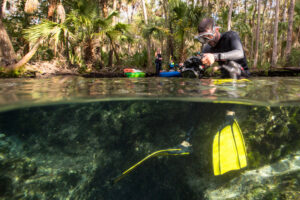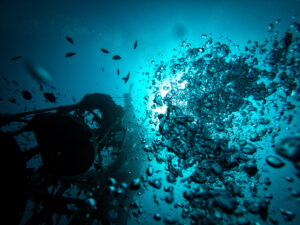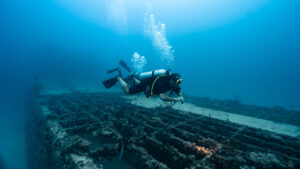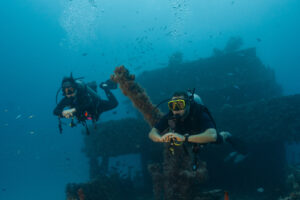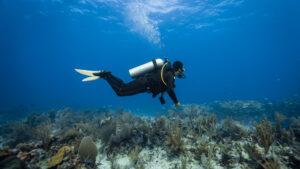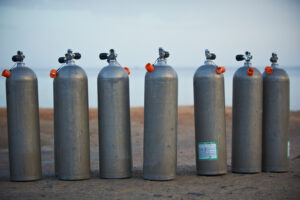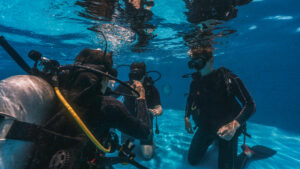What is Wet Filling?
Wet filling is a process used in scuba diving to fill diving cylinders with gas while they are submerged in water. This method is important for ensuring safety and efficiency in scuba diving. By understanding the intricacies of wet filling, divers can better appreciate its significance and the technical considerations involved.
Understanding Wet Filling
Wet filling involves the submersion of a diving cylinder in a water bath during the gas filling process. This technique helps to manage the heat generated when compressing gas into the cylinder. As gas is compressed, it heats up, and if not properly managed, this heat can cause the cylinder to become dangerously hot, leading to potential safety hazards. The water bath acts as a coolant, absorbing the heat and maintaining the cylinder at a safer temperature.
The water used in wet filling is typically at ambient temperature and is chosen for its ability to absorb heat efficiently. The process also helps to detect leaks. If bubbles appear in the water, it indicates a leak in the cylinder or valve. This immediate feedback allows for quick corrective actions, ensuring the integrity of the cylinder before it is used for diving.
Wet filling is particularly useful when filling cylinders with gases like pure oxygen or nitrox mixtures, which require careful handling due to their reactive nature. By managing the temperature and potential leaks, wet filling enhances the safety of preparing these gases for use in scuba diving.
Historical Background
The technique of wet filling has evolved significantly over the years. In the early days of scuba diving, filling cylinders was a rudimentary process, often done without much regard for the heat generated. As the understanding of gas laws and thermodynamics improved, divers and technicians began to recognize the need for better safety measures.
In the mid-20th century, advancements in diving technology led to the development of more sophisticated methods for filling cylinders. The introduction of high-pressure compressors brought about the need for better temperature management, which in turn led to the adoption of wet filling. Early adopters of this method found that submerging cylinders in water during filling not only improved safety but also extended the lifespan of the cylinders by reducing thermal stress.
As the diving community grew and safety standards became more stringent, wet filling became a standard practice in many parts of the world. Diving organizations and regulatory bodies started to incorporate wet filling guidelines into their protocols, ensuring that this method was widely understood and implemented.
Technical Aspects of Wet Filling
Wet filling is a complex process that involves several technical considerations. At its core, it requires a water bath, a high-pressure compressor, and the diving cylinder to be filled. The water bath must be large enough to fully submerge the cylinder and maintain a consistent temperature throughout the filling process.
The choice of gas is crucial in wet filling. Different gases behave differently under compression, and this affects the filling process. For example, filling a cylinder with air, which is mostly nitrogen and oxygen, is relatively straightforward. However, filling with nitrox, which is a mixture of nitrogen and oxygen with a higher concentration of oxygen, requires more careful handling due to the increased reactivity of oxygen. Pure oxygen filling is even more sensitive, necessitating strict adherence to safety protocols to prevent combustion or other hazardous reactions.
The equipment used in wet filling is designed to withstand high pressures. The compressor must be capable of delivering gas at pressures up to 3000 psi (approximately 207 bar) or more. The cylinder itself must be inspected regularly to ensure it can handle these pressures without risk of failure. Hydrostatic testing is one common method used to check the integrity of cylinders. During this test, the cylinder is filled with water and pressurized to a level higher than its normal operating pressure to ensure it can withstand the stress.
Safety Considerations
Safety is paramount in the wet filling process. One of the primary risks associated with wet filling is the potential for cylinder failure due to overheating. If the heat generated during filling is not adequately managed, it can weaken the cylinder walls and increase the risk of rupture. This is why the water bath is essential; it absorbs the heat and helps to keep the cylinder at a safe temperature.
Another safety concern is the potential for leaks. Wet filling helps to identify leaks quickly because any escaping gas will form bubbles in the water bath. This immediate visual indication allows technicians to stop the filling process and address the leak before it becomes a more significant issue. Regular maintenance and inspection of cylinders and valves are critical to minimizing the risk of leaks.
The choice of gas also influences safety protocols. Gases like nitrox and pure oxygen require careful handling to prevent reactions that could lead to fires or explosions. Special training is needed to handle these gases safely, and filling stations must adhere to strict guidelines to ensure the process is carried out correctly.
There have been instances where improper wet filling techniques have led to accidents. For example, if a cylinder is not fully submerged in the water bath, parts of it can overheat, leading to uneven stress distribution and potential failure. Learning from such incidents, the diving community has developed comprehensive safety standards and training programs to ensure that wet filling is performed safely.
Practical Applications
Wet filling is commonly used in both recreational and professional diving scenarios. In recreational diving, it is often employed when preparing cylinders for extended diving sessions where multiple tanks are filled in quick succession. The ability to manage heat efficiently and detect leaks ensures that divers have reliable and safe air supplies.
In technical diving, wet filling is even more critical. Technical divers often use gas mixtures like nitrox, trimix, and pure oxygen, which require precise handling. Wet filling helps to manage the complexities associated with these gases, providing a safer way to prepare cylinders for deep dives or extended bottom times. The process also supports the use of larger cylinders, which are common in technical diving, by ensuring that the filling process does not compromise the structural integrity of the cylinders.
Military and commercial divers also rely on wet filling. These divers operate in demanding environments and require absolute reliability from their equipment. Wet filling provides an additional layer of safety, ensuring that cylinders are filled correctly and that any potential issues are identified and addressed promptly.
Future of Wet Filling
The future of wet filling in scuba diving looks promising, with ongoing innovations aimed at improving safety and efficiency. One area of development is the use of advanced materials for cylinders that can better withstand the stresses of filling and use. New alloys and composite materials are being tested to provide stronger, lighter cylinders that are less prone to failure.
Another exciting development is the integration of smart technology into the filling process. Sensors that monitor temperature, pressure, and gas composition in real-time can provide instant feedback to technicians, allowing for more precise control over the filling process. These technologies could also be used to automate parts of the filling process, reducing the potential for human error and further enhancing safety.
Environmental considerations are also driving changes in wet filling practices. As the diving community becomes more conscious of its impact on the environment, there is a push to develop more sustainable practices. This includes finding ways to reduce water usage in wet filling and developing systems that can recycle and purify water used in the process.
As these innovations take hold, the standards and practices around wet filling will continue to evolve. Training programs will incorporate new technologies and materials, ensuring that divers and technicians are equipped with the latest knowledge and skills to perform wet filling safely and effectively.
Key Takeaways
Wet filling is a crucial process in scuba diving, involving the submersion of cylinders in water during gas filling to manage heat and detect leaks. It has evolved significantly, with ongoing innovations aimed at improving safety and efficiency. Understanding the technical aspects and safety considerations of wet filling is essential for divers and technicians to ensure the reliability and safety of diving cylinders.



